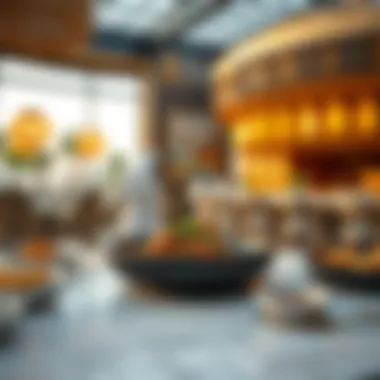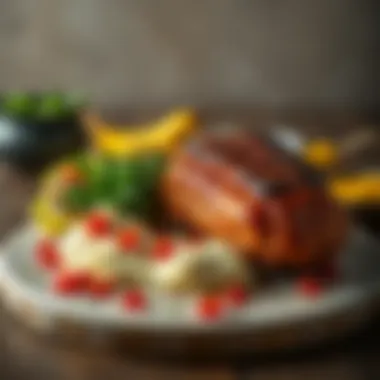Traditional Emirati Cuisine: A Culinary Journey


Intro
When we think about traditional Emirati cuisine, it takes us on a journey through history, culture, and a blend of flavors that are both unique and memorable. In the UAE, food isn’t just sustenance; it's a means of connection to the land and a reflection of its rich heritage. Local ingredients, historical influences, and cooking techniques all play critical roles in shaping what we eat today.
Dishes like Al Harees and Shawarma unravel tales of the Bedouin past, while international flavors seep in, showcasing the UAE's position as a crossroads of cultures. Understanding these nuances might seem like a hefty task, but it’s about diving into the local markets and kitchens, where the magic happens.
In this exploration, we will look at the essential aspects of Emirati food, touching on everything from key ingredients and popular dishes to the influences that have molded the culinary landscape. The interaction between tradition and modern trends creates a rich tapestry worth unraveling.
From the spice markets bustling with aromas to communal meals that strengthen bonds, each element of this culinary scene tells a story. Our goal is to provide a peek into these vibrant traditions, emphasizing how they've evolved yet remain foundational to Emirati identity.
As we embark on this delicious adventure, let’s keep in mind not just what’s on the plate, but also what it represents—community, culture, and continuity.
Foreword to Emirati Cuisine
Emirati cuisine is not just a mere collection of recipes; it is the essence of a culture that fuses history, tradition, and the bounty of the land and sea. Within this exploration of the culinary landscape of the UAE, we delve into the flavors and customs that define its food, making it a unique part of the Emirati identity. The significance of understanding Emirati cuisine lies in the way it reflects the unity and diversity of its people, showcasing the story of their heritage and evolution.
From the early Bedouin communities to the bustling markets of modern cities like Dubai and Abu Dhabi, the culinary practices transmitted through generations tell tales of daily life, survival, and celebration. This introduction sets the stage for uncovering the layers of history that shape today's meals, emphasizing the benefits of recognizing these elements for anyone looking to immerse themselves in Emirati society.
Historical Influences on Emirati Food
The roots of Emirati cuisine run deep, nourished by a variety of influences. Historically, the region was a melting pot of cultures due to trade routes that connected the Arabian Peninsula to Persia, India, and beyond. The ingredients and cooking techniques brought in by various traders and nomadic tribes have created a diverse culinary landscape.
For instance, the spice trade has left an indelible mark on the flavors found in dishes like Machboos, a spiced rice dish often served during gatherings. The introduction of saffron and cardamom, primarily from India, has vividly influenced the aroma and taste of Emirati meals.
Furthermore, the Islamic dietary laws have shaped food practices significantly. The concept of halal has always been integral, dictating what is permissible to consume. Additionally, the presence of seafood in the diet reflects the UAE's geographical proximity to the Arabian Gulf—providing a bounty that locals have depended on for centuries.
"The true essence of Emirati food lies in the communal spirit it promotes, often enjoyed in large gatherings where families and friends come together to share stories and meals."
The Role of Geography in Culinary Practices
Geography plays a pivotal role in defining the culinary identity of the UAE. The country's expansive coastline offers a variety of seafood, while the vast desert influences the choice of ingredients and cooking methods. The natural environment has shaped dietary habits over time, as the Bedouins relied heavily on dates, camel milk, and grain for sustenance.
In the northern emirates, mountainous terrain influences the types of crops grown, which tend to differ from those in the flat desert regions. Here, fresh herbs and vegetables find their way into the regional kitchens, adding to the variety of flavors.
Moreover, the seasonal availability of certain foods drives the way locals cook and eat. Much like how the tides of the Gulf dictate fishing practices, the seasons affect what is served on the table—encouraging eating with the earth’s cycles. Residents take pride in preserving traditional cooking methods while using modern touches, bridging generations through flavors.
Understanding the geographical impacts on cuisine assists with appreciating the intricate relationship between the people and their land. Whether dining on a plate of freshly caught fish or savoring a slow-cooked Al Harees, each dish whispers stories of places, influences, and the enduring ties to culture.
Fundamental Ingredients in Emirati Dishes
The heart of any cuisine lies in its ingredients, and Emirati food is no exception. The dishes that define this culinary tradition showcase a balance of flavors, textures, and aromas. Understanding these fundamental ingredients profoundly enhances one's appreciation of Emirati dishes. These core elements not only contribute to the taste but also tell stories of local culture, trade history, and agricultural practices.
Common Spices and their Uses


Spices play a pivotal role in Emirati cuisine, carrying the signature warmth and richness that elevate simple ingredients to extraordinary dishes. Here are some spices that are central to many traditional Emirati preparations:
- Cumin: This earthy spice is often used in stews and rice dishes to impart a warm aroma and slight bitterness.
- Cardamom: Known for its unique flavor, cardamom is another essential spice in Emirati cooking, often used in coffee and various desserts. Its fragrant profile can brighten up any dish.
- Turmeric: This spice is easily recognized for its bright yellow hue, providing not only color but also a subtle earthy flavor to meals.
- Cinnamon: Though commonly known as a sweet spice, cinnamon in Emirati cuisine is used to spice up savory dishes, especially those featuring meat.
- Saffron: Perhaps the most luxurious of spices, saffron is prized for its distinct color and flavor, often added to rice dishes like Machboos.
These spices, combined in various ways, create a complex flavor profile that is characteristic of Emirati food. Each has its place, contributing not just flavor but also health benefits, making dishes not only delicious but nourishing.
Staples and their Importance
The staples of Emirati cuisine provide the backbone upon which many dishes are built. These ingredients reflect the agricultural practices and historical influences that shaped the region. Key staples include:
- Rice: A fundamental part of the Emirati diet, rice is often the base for many meals, particularly the beloved Machboos. Different varieties of rice, such as Basmati and local types, offer distinct flavors and textures.
- Wheat: Used to make breads like Khameer and chapatis, wheat is a major ingredient that is both filling and essential.
- Fish: Given the UAE's coastal geography, fish is a core component, with varieties like Hammour being particularly popular. It connects diners to the maritime history of the region.
- Lentils: These are often included in traditional stews and salads, providing a good source of protein and a hearty texture.
- Dates: Not just a traditional snack, dates are integral to cultural practices. They are often served with Arabic coffee and symbolize hospitality.
These staples not only nourish but also hold great cultural significance, revealing much about the people of the UAE. Understanding their importance can deeply enrich one's experience of Emirati cuisine, making every meal a little journey into the heart of the culture.
"The ingredients in Emirati food are more than just components; they're the embodiment of a way of life and connection to the land."
In summary, familiarizing oneself with these fundamental ingredients is crucial for anyone wishing to navigate the rich tapestry of Emirati culinary heritage. The flavors created through the interaction of these spices and staples present a narrative that reflects the diverse influences and historical context of the region. As Emirati cuisine continues to evolve, these core ingredients remain a vital link to its past, while also paving the way for innovative culinary practices.
Signature Dishes of the UAE
The signature dishes of the UAE do not merely represent food. They embody a tapestry of culture, tradition, and the spirit of the people who have shaped the culinary landscape over centuries. Each dish tells a story, is steeped in history, and is laden with meaning. For investors and expatriates alike, understanding these signature dishes opens a window into the UAE's rich cultural heritage, making it invaluable in appreciating the local lifestyle.
Al Harees: A Traditional Favorite
Al Harees is one of those classic Emirati dishes that warm the heart. It’s a humble dish made from wheat and meat, slow-cooked until it reaches a creamy consistency. The preparation involves a time-honored method of boiling the wheat and meat together, stirring regularly until the mixture becomes a porridge-like texture. Traditionally, it is served during festive occasions such as weddings and Ramadan.
The beauty of Al Harees lies in its simplicity. Eaten by hand and often enjoyed with a drizzle of ghee, it represents unity and togetherness at family gatherings. For those attending an Emirati celebration, trying Al Harees is not optional; it’s essential. A hint of salt brings out the natural flavors, making the dish comforting yet memorable.
"Al Harees reflects the spirit of hospitality, making every guest feel at home with its warmth."
Machboos: The Spiced Rice Dish
Machboos is another cornerstone of Emirati cuisine and goes beyond mere sustenance. This dish stands out with its intoxicating mix of spices, rice, and usually lamb or chicken. The rice is perfumed with saffron, cardamom, and bay leaves, creating a dish that is as fragrant as it is delicious. The addition of vegetables such as tomatoes and onions adds depth to the flavor profile.
Machboos is often served at family meals and special occasions, embodying the essence of Emirati hospitality. Cooking it requires patience; the slow simmer allows the spices to fully infuse the rice and meat, resulting in a dish that sings of tradition. For investors, chefs, and culinary experts visiting the UAE, experimenting with Machboos provides insights into the local palate, revealing much about the society's preferences.
Shawarma: Global Adaptation of a Classic
Then, there’s Shawarma, a dish renowned beyond the borders of the UAE. While its roots lie in Middle Eastern cuisine, the Emirati version carries a distinct flair that sets it apart. Succulent slices of marinated meat—be it beef, chicken, or lamb—are cooked on a vertical rotisserie and served in pita bread with a plethora of toppings. The garlic sauce, tahini, and fresh vegetables create an irresistible combination of flavors.
Shawarma represents the crossroads of tradition and globalization. Its adaptation by street vendors and high-end restaurants alike highlights a striking culinary evolution. It's a must-try for expatriates and visitors, as indulging in a Shawarma is not just about the food. It's about experiencing the vibrant, bustling atmosphere of the UAE's food markets.
In summary, the signature dishes of the UAE serve as a window into the traditions and cultures that shape Emirati identity. Al Harees, Machboos, and Shawarma each tell their own story, filled with significance that resonates both locally and globally. Understanding these dishes is crucial for anyone looking to immerse themselves in the cultural fabric of the UAE.


The Art of Cooking Emirati Food
The preparation of Emirati food is a significant aspect of the culture. It's not merely about nourishing the body; it brings together families, reflects traditions, and showcases the rich history of the Emirati people. Cooking in this context is an expression of identity, making it crucial to understand the culinary methods and tools used in crafting these traditional dishes.
From slow-cooking to sharing meals, there's a unique process involved that connects generations. The nuances of these culinary practices can provide insight into Emirates society and its vibrant culture. It shows how food can be a bridge to understanding a people—understanding their past and the journey they’ve made to the present.
Traditional Techniques and Tools
Emirati cooking employs a variety of time-honored techniques, many passed down through the years. One of the most notable methods is the use of the ‘tabakh’, a unique vessel used for slow-cooking stews or rice dishes over a charcoal flame. This method allows flavors to meld beautifully over time, creating hearty dishes that are comforting and rich.
Another vital technique is grilling, widely used for meats. This method isn't just about cooking; it's about imparting distinct flavors through smoke and heat. The preparation of shish kebabs and grilled fish exemplifies this practice, bringing a smoky essence to tender meats. In terms of tools, most Emirati homes have the stone grinder, known locally as 'al-mahalab,' used for grinding spices.
Modern Influences on Cooking Methods
As the world evolves, so does Emirati cuisine. The advent of technology has introduced modern equipment, making cooking faster and more efficient while still retaining the essence of traditional dishes. For instance, pressure cookers and electric grills have taken a front seat in many kitchens today. This allows younger cooks to experiment with classic dishes, incorporating their own flair while staying rooted in tradition.
Moreover, the influence of global cuisine has further diversified cooking practices in the region. The rise of gourmet restaurants offering fusion dishes shows how Emirati chefs creatively adapt their heritage with contemporary techniques. An example is the use of sous-vide cooking in preparing traditional dishes to enhance flavors and texture without losing authenticity.
Cooking, at its core, adapts, evolves, and in doing so, reflects the society around it.
All in all, the art of cooking Emirati food is a blend of time-honored traditions and modern adaptations that continue to tell the story of a people and their culture. Each dish prepared serves not only as a meal but as a reminder of the bonds of family and community that define Emirati heritage.
For those wanting to dive deeper into Emirati culture, resources such as Wikipedia or Britannica offer enriched insights into the history and evolution of this fascinating cuisine.
Emirati Culinary Customs and Traditions
Emirati culinary customs and traditions are woven deeply into the fabric of the nation’s identity. They serve not only to connect people with their heritage but also to foster a sense of community, making every meal a collective experience. Throughout history, the act of sharing food has been integral to Emirati culture, symbolizing hospitality and generosity. Understanding these customs aids in appreciating the nuances of Emirati cuisine, from the ceremonial aspects to how meals are enjoyed or prepared.
Serving Etiquette in Emirati Culture
In Emirati culture, serving etiquette transcends mere dining rules; it’s a reflection of respect and honor. Traditionally, meals are served on large platters, bringing people together around the table—this represents unity and shared responsibilities. It’s common to see diners using their right hand to eat, as the left hand is reserved for less sanitary tasks. For guests, accepting food offered is more than just a courtesy; it’s a sign of appreciation.
When a host serves, they often begin with the eldest or most honored guest. This practice emphasizes deep-rooted values of respect. It’s customary to offer coffee, specifically Gahwa, and dates before main meals, as this act sets the stage for warmth and welcome.
The meal often starts with a prayer, and family or friends gather to eat together, creating a bond over delicious dishes. One might say, it’s like gathering for a heartwarming anecdote—everyone has their role in it.
Festive Foods and Celebrations
Emirati food shines brightest during celebrations and festivals, where traditional dishes take center stage. Events such as Eid al-Fitr and weddings bring out a flurry of culinary delights. Dishes like Khuzi, a flavorful lamb dish served with rice, are often prepared in large quantities, symbolizing abundance and thanks.
Festivals are opportunities for families to showcase their best cooking skills and pass down culinary knowledge through generations. Each dish carries tales and traditions, celebrating not just the occasion but also the culture itself.
- Traditional Foods During Festivities Include:


- Al Majboos: A spiced rice dish coupled with meat or fish
- Samboosa: Savory pastries filled with meat and spices
- Biryani: A fragrant rice dish often prepared for gatherings
Children also partake in the festivities, enjoying sweets like Knafa and Baklava, teaching them the importance of food in cultural expression. Overall, the culinary customs of the UAE highlight how vital food is in fostering relationships and celebrating culture.
"Food is not just sustenance; it is a bridge to understanding and heritage."
Navigating Dietary Trends in the UAE
The culinary landscape in the United Arab Emirates is witnessing a profound transformation, intertwined with global influences and shifting dietary habits. As people become increasingly health-conscious, traditional Emirati cuisine is adapting to meet these modern nutritional expectations. This section aims to explore how such trends are not only reshaping the food scene in the UAE but are also allowing the rich heritage of Emirati cuisine to find its place alongside contemporary dietary practices.
Health Consciousness and Traditional Flavors
In today’s world, where health is often prioritized, Emiratis are veering towards mindful eating without letting go of their cultural roots. Traditional flavors are being reinterpreted to create dishes that not only pay homage to the past but also cater to a more health-conscious palate. The movement towards organic and locally-sourced ingredients plays a crucial role in this shift. For instance, spices like za’atar and sumac, once primarily appreciated for their flavor, are now celebrated for their health benefits, including antioxidant properties.
Moreover, you’ll find more chefs emphasizing techniques that preserve the nutritional integrity of the ingredients. Steaming, baking, and grilling have taken precedence over frying, making it easier for people to enjoy dishes like shorbat adas (lentil soup) while maintaining health standards. The emphasis is largely on balance, keeping the rich flavors of history alive, while ensuring meals are lighter and healthier.
"Culinary evolution is not abandoning tradition; it's about making tradition relatable to the contemporary diner."
Fusion Cuisine: Bridging the Old and New
The concept of fusion cuisine isn’t new; it encompasses the very essence of cultural exchange. In the UAE, where East meets West, fusion food has become a delicious norm. Chefs are blending traditional Emirati recipes with international influences, creating dishes that are both innovative and reflective of the UAE’s diverse population.
Take, for instance, spiced shawarma tacos, a delightful marriage of Middle Eastern and Mexican flavors. Or consider machboos, a traditional spiced rice dish, now served with a twist—like infused with truffle oil or accompanied by gourmet seafood.
This bridging of cultural gaps not only tantalizes taste buds but also sparks conversations about identity and the future of Emirati cuisine in a global context. Food festivals and pop-ups are places where this fusion shines, allowing locals and visitors to explore culinary creativity firsthand.
In summary, as Emirati cuisine continues to navigate through modern dietary trends, it remains a vivid tapestry reflecting both tradition and innovation. The interplay between health consciousness and fusion cuisine highlights how the culinary identity of the UAE is being redefined, paving the way for a unique culinary experience that honors the past while looking towards the future.
Culmination: The Future of Emirati Cuisine
As the Emirati culinary landscape continues to evolve, it becomes increasingly vital to understand both its roots and its future. Traditional recipes are often the heart of a culture, and how they adapt to modern influences reflects broader trends in globalization and cultural exchange. This section delves into two main areas of interest: preserving heritage in a modern world and the role of Emirati cuisine in the global gastronomic context.
Preserving Heritage in a Modern World
In today’s fast-paced world, maintaining culinary traditions can be a tall order. Many young Emiratis are pulled in various directions by modern lifestyles and global influences, which can lead to a decline in the practice of cooking traditional dishes. Yet, some families hold onto their culinary heritage tenaciously; they pass down recipes like family heirlooms. This preservation is not just about cooking; it’s about sharing stories, memories, and the rich cultural identity that comes with each dish.
Local initiatives are aiming to revive these traditions by teaching cooking classes in community centers and schools. For instance, many Emirati women, who have long been the keepers of culinary knowledge, are now becoming ambassadors of their heritage, offering workshops that encompass not only food preparation but also discussions on the historical significance of each dish. Techniques like "slow cooking" and the use of organic ingredients are making a comeback, connecting the past with the present.
- Community engagement: Efforts like local food festivals draw in not just locals but also tourists eager to know about the authentic taste of the Emirates.
- Technology’s role: Social media is another ally in this cause, as platforms like Instagram allow for a visual celebration of traditional dishes, reaching a global audience.
- Sustainability: More chefs are embracing sustainable practices, ensuring that not only is traditional food preserved, but it's prepared with consideration for the environment too.
"Food is our common ground, a universal experience." - James Beard
By valuing the lessons from the past and embracing healthy cooking methods, Emirati cuisine can thrive in a world that is swiftly changing.
Emirati Food in the Global Context
The global food scene is characterized by an ever-increasing appetite for diverse culinary experiences. Emirati cuisine, with its rich tapestry of flavors, has slowly begun to carve out its niche on this worldwide stage. While dishes like Shawarma have crossed borders and gained international fame, other traditional foods are beginning to make their mark as well.
- Culinary diplomacy: Participating in international expos and food festivals helps showcase Emirati cuisine to a broader audience, fostering understanding and appreciation of its unique flavors.
- Fusion culture: Many chefs are experimenting by incorporating Emirati ingredients into global dishes, creating exciting combinations that respect cultural roots while also appealing to contemporary palates. A good example is blending local spices with Italian risottos or Indian curries.
- Tourism impact: As tourism flourishes in the UAE, travelers are increasingly seeking authentic dining experiences. This trend pushes local chefs to innovate while still emphasizing traditional roots, thereby enhancing the appeal of Emirati cuisine as a vital part of the tourism experience.
The future of Emirati cuisine lies in striking a balance between honoring tradition and embracing innovation. As it gets global recognition, it will be intriguing to see how it adapts and evolves while still holding onto its essence. Traditional Emirati dishes can remain relevant even in the modern culinary world, provided there is an ongoing effort to elevate and celebrate them.



